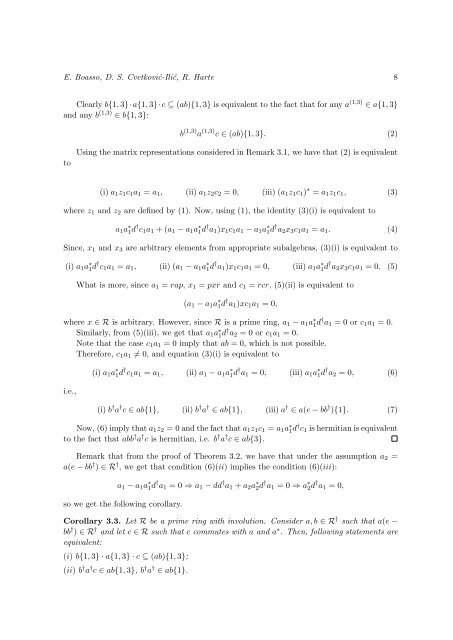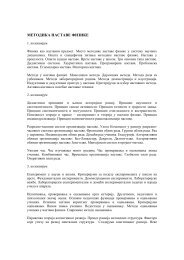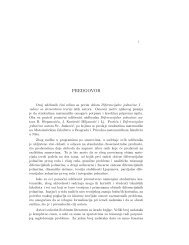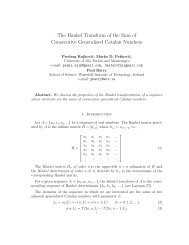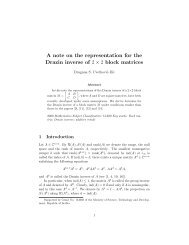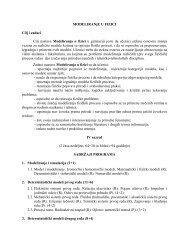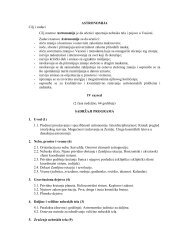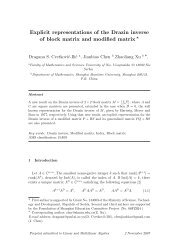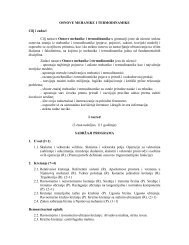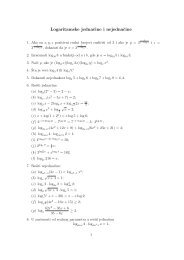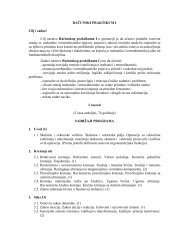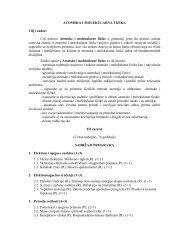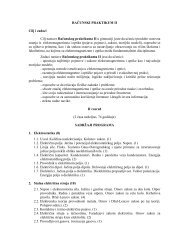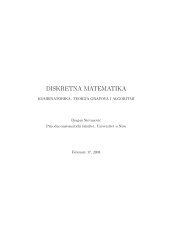On weighted reverse order laws for the Moore-Penrose inverse and ...
On weighted reverse order laws for the Moore-Penrose inverse and ...
On weighted reverse order laws for the Moore-Penrose inverse and ...
Create successful ePaper yourself
Turn your PDF publications into a flip-book with our unique Google optimized e-Paper software.
E. Boasso, D. S. Cvetković-Ilić, R. Harte 8<br />
Clearly b{1, 3}·a{1, 3}·c ⊆ (ab){1, 3} is equivalent to <strong>the</strong> fact that <strong>for</strong> any a (1,3) ∈ a{1, 3}<br />
<strong>and</strong> any b (1,3) ∈ b{1, 3}:<br />
b (1,3) a (1,3) c ∈ (ab){1, 3}. (2)<br />
to<br />
Using <strong>the</strong> matrix representations considered in Remark 3.1, we have that (2) is equivalent<br />
(i) a 1 z 1 c 1 a 1 = a 1 , (ii) a 1 z 2 c 2 = 0, (iii) (a 1 z 1 c 1 ) ∗ = a 1 z 1 c 1 , (3)<br />
where z 1 <strong>and</strong> z 2 are defined by (1). Now, using (1), <strong>the</strong> identity (3)(i) is equivalent to<br />
a 1 a ∗ 1d † c 1 a 1 + (a 1 − a 1 a ∗ 1d † a 1 )x 1 c 1 a 1 − a 1 a ∗ 1d † a 2 x 3 c 1 a 1 = a 1 . (4)<br />
Since, x 1 <strong>and</strong> x 3 are arbitrary elements from appropriate subalgebras, (3)(i) is equivalent to<br />
(i) a 1 a ∗ 1d † c 1 a 1 = a 1 , (ii) (a 1 − a 1 a ∗ 1d † a 1 )x 1 c 1 a 1 = 0, (iii) a 1 a ∗ 1d † a 2 x 3 c 1 a 1 = 0. (5)<br />
What is more, since a 1 = rap, x 1 = pxr <strong>and</strong> c 1 = rcr, (5)(ii) is equivalent to<br />
(a 1 − a 1 a ∗ 1d † a 1 )xc 1 a 1 = 0,<br />
where x ∈ R is arbitrary. However, since R is a prime ring, a 1 − a 1 a ∗ 1 d† a 1 = 0 or c 1 a 1 = 0.<br />
Similarly, from (5)(iii), we get that a 1 a ∗ 1 d† a 2 = 0 or c 1 a 1 = 0.<br />
Note that <strong>the</strong> case c 1 a 1 = 0 imply that ab = 0, which is not possible.<br />
There<strong>for</strong>e, c 1 a 1 ≠ 0, <strong>and</strong> equation (3)(i) is equivalent to<br />
i.e.,<br />
(i) a 1 a ∗ 1d † c 1 a 1 = a 1 , (ii) a 1 − a 1 a ∗ 1d † a 1 = 0, (iii) a 1 a ∗ 1d † a 2 = 0, (6)<br />
(i) b † a † c ∈ ab{1}, (ii) b † a † ∈ ab{1}, (iii) a † ∈ a(e − bb † ){1}. (7)<br />
Now, (6) imply that a 1 z 2 = 0 <strong>and</strong> <strong>the</strong> fact that a 1 z 1 c 1 = a 1 a ∗ 1 d† c 1 is hermitian is equivalent<br />
to <strong>the</strong> fact that abb † a † c is hermitian, i.e. b † a † c ∈ ab{3}.<br />
Remark that from <strong>the</strong> proof of Theorem 3.2, we have that under <strong>the</strong> assumption a 2 =<br />
a(e − bb † ) ∈ R † , we get that condition (6)(ii) implies <strong>the</strong> condition (6)(iii):<br />
a 1 − a 1 a ∗ 1d † a 1 = 0 ⇒ a 1 − dd † a 1 + a 2 a ∗ 2d † a 1 = 0 ⇒ a ∗ 2d † a 1 = 0,<br />
so we get <strong>the</strong> following corollary.<br />
Corollary 3.3. Let R be a prime ring with involution. Consider a, b ∈ R † such that a(e −<br />
bb † ) ∈ R † <strong>and</strong> let c ∈ R such that c commutes with a <strong>and</strong> a ∗ . Then, following statements are<br />
equivalent:<br />
(i) b{1, 3} · a{1, 3} · c ⊆ (ab){1, 3};<br />
(ii) b † a † c ∈ ab{1, 3}, b † a † ∈ ab{1}.


